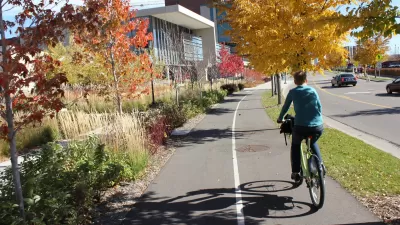In the first of two articles looking at how Minneapolis-St. Paul can remain a prosperous and livable place, Jay Walljasper examines the Twin Cities' identity crisis.
"Twin Cities, we have a problem!" says Jay Walljasper, who has authored a report for the McKnight Foundation’s Food for Thought series on the prospects for the continued vitality of Minneapolis-St. Paul. "We’re not on most people’s radar of lively, livable, progressive, prosperous, places. The cities we compete with for business, jobs and well-educated young workers enjoy strong identities as attractive, interesting places."
Yet, notes Ann Markusen, director of the Humphrey School of Public Affairs’ Project on Regional and Industrial Economies, “On many economic and quality of life features, the Twin Cities outperforms other much admired metros — Boston, Denver, Seattle, Portland, San Francisco and San Diego. Higher educational attainment, higher labor force participation, better job opportunities for young people, lower unemployment, and higher median income adjusted for cost of living.”
"But none of this makes any difference if we keep it to ourselves," says Walljasper. "To pay only scant attention to our image in a globalized age is the equivalent of relying on a landline and P.O. box with no email, Facebook, twitter, texting or Instagram. For young people especially, who’ve internalized 'The Brand Called You' ethic of our times, reticence in talking up our strengths is interpreted as being feeble rather than being modest."
FULL STORY: Minneapolis-St. Paul’s identity crisis could mean trouble for our future

Planetizen Federal Action Tracker
A weekly monitor of how Trump’s orders and actions are impacting planners and planning in America.

Maui's Vacation Rental Debate Turns Ugly
Verbal attacks, misinformation campaigns and fistfights plague a high-stakes debate to convert thousands of vacation rentals into long-term housing.

San Francisco Suspends Traffic Calming Amidst Record Deaths
Citing “a challenging fiscal landscape,” the city will cease the program on the heels of 42 traffic deaths, including 24 pedestrians.

Amtrak Rolls Out New Orleans to Alabama “Mardi Gras” Train
The new service will operate morning and evening departures between Mobile and New Orleans.

The Subversive Car-Free Guide to Trump's Great American Road Trip
Car-free ways to access Chicagoland’s best tourist attractions.

San Antonio and Austin are Fusing Into one Massive Megaregion
The region spanning the two central Texas cities is growing fast, posing challenges for local infrastructure and water supplies.
Urban Design for Planners 1: Software Tools
This six-course series explores essential urban design concepts using open source software and equips planners with the tools they need to participate fully in the urban design process.
Planning for Universal Design
Learn the tools for implementing Universal Design in planning regulations.
Heyer Gruel & Associates PA
JM Goldson LLC
Custer County Colorado
City of Camden Redevelopment Agency
City of Astoria
Transportation Research & Education Center (TREC) at Portland State University
Jefferson Parish Government
Camden Redevelopment Agency
City of Claremont





























